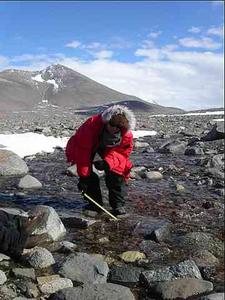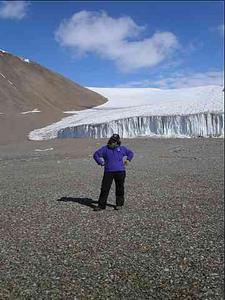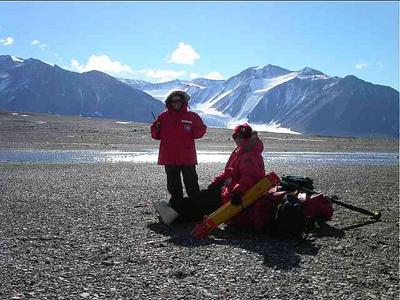10 January, 2003
Upper Delta Stream
Sun streamed into my tent at 7:00 AM this morning and woke me up.
The tent had warmed to the point of being almost too hot, but it was
nice to get dressed without feeling I had to hurry to keep from
freezing! The weather is so changeable. Last night we actually had a
"snowstorm." Remember: this is the Dry Valleys. The sky got very
dark with low clouds, the air took on a bone chilling feel, and there
were several snowflakes. Of course there was no accumulation. Then
this morning the clouds were gone and the sun was baking us like a
day at the beach. Truly we have to put on lots of suntan lotion. Our
faces are getting tanned no matter what we do, but we look like
Antarctic raccoons, because we also always wear goggles or sunglasses.
The temperature can climb to the upper thirties and then the sun
goes behind a cloud and it drops like a stone. The amazing thing
about the changes in temperature is that it can be seen immediately
in the stream flow. The streams on our side of the lake usually flow
slowly in the morning and then increase dramatically when the sun is
shining on the glaciers. Just as quickly though, when the sun goes
behind a cloud, the streams turn off. It is an incredibly sensitive
ecological system.
Susan Monroe, a chemist from Crary Lab in McMurdo, came out to
spend a day helping Jen and me do an algae transect. The helo
delivered her to F6 and later another came back to pick the three of
us up and all our gear. We flew to Upper Delta Stream. Delta is about
eleven kilometers long, so walking to the top with all of our
equipment would have been pretty difficult. Barry, our pilot, put us
down as close as he could get to the coordinates we had. Our worst
complication is that sometimes the markers where we do our surveying
from are very hard to find. If we can't find them, we can't take the
samples or do the work we need to do. Today we had to walk over four
miles and spent about three hours hunting for them. They are little
tiny bolts in a big rock--but there are literally millions of rocks
that all look alike. It's like hunting for a needle in a haystack.
Some are marked with a stack of rocks called a rock cairn. THOSE I
like, because I'm pretty good at spotting them. They are more like
hunting for Easter eggs!
We were worried that by getting such a late start we would never
get done, but we finished in record time. Susan was a big help and
learned to take algae samples like a pro! The best part of today was
that it was an absolutely bright, clear day. We were up high and
could see the details of the glaciers that line the valley, and more
than once we would stop our work and say, "Wow! Isn't it beautiful!"
The water of the streams glistened and the sun reflected brightly.
For months after I found out I had been chosen to go to
Antarctica, I would wake up with a jolt and say, "Omigosh! I'm going
to Antarctica!" The uniqueness has not worn off. I find myself
stopping during the day and saying, "Omigosh! I'm IN Antarctica!"

1. Jen teaches Susan to use the Pygmy Meter to
measure the stream flow rate. You wear earphones and the meter turns
in the water making a clicking sound with each revolution. The person
doing the measuring counts the number of clicks it makes in 40
seconds.

2. Me doing my least favorite job: the pebble count.
You stand in the stream and randomly measure the long and short sides
of 100 pebbles. Your feet get wet, your hands are freezing and it
doesn't do much for your back either. But it's all for science! (Jen
is still the fastest pebble counter in the south. I don't even begin
to approach her speed.)

3. Me in front of the Howard Glacier. I'm happy just
to be here!

4. Jen and Susan waiting for the helicopter to come
back and pick us up. That's the Canada Glacier in the background and
the Upper Delta Stream glittering in the foreground.
Contact the TEA in the field at
.
If you cannot connect through your browser, copy the
TEA's e-mail address in the "To:" line of
your favorite e-mail package.
|
